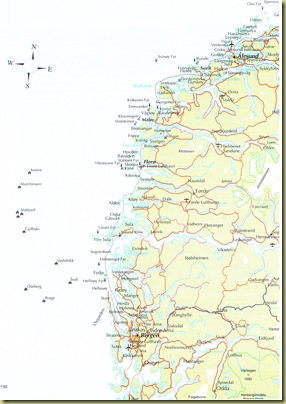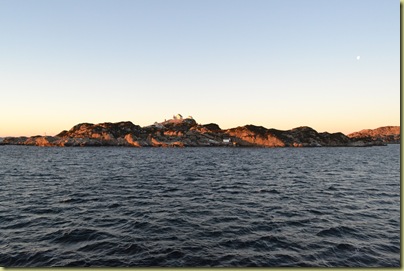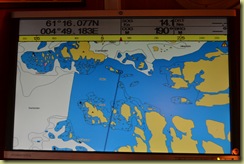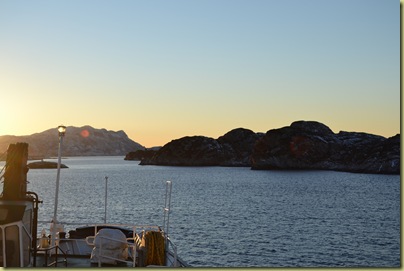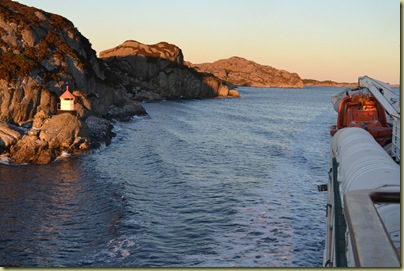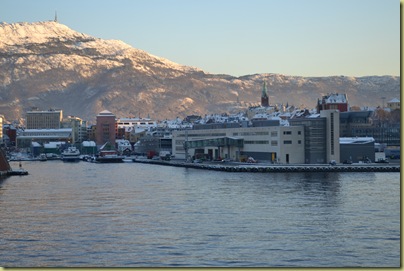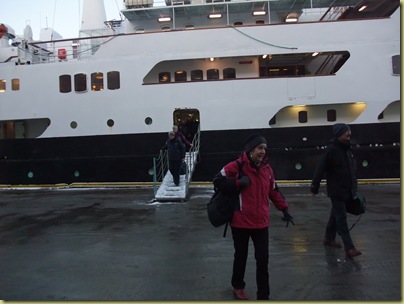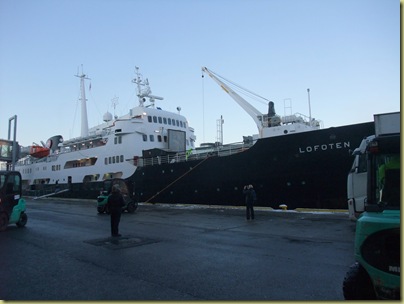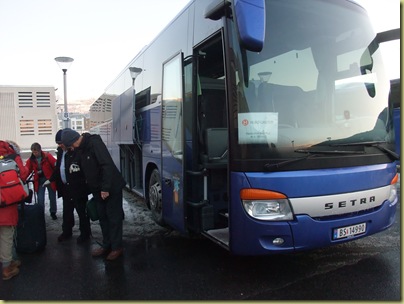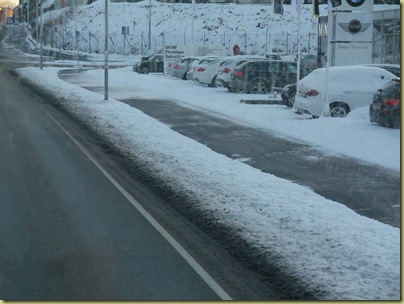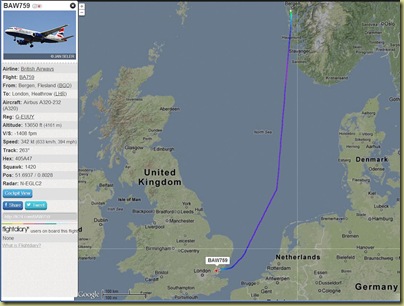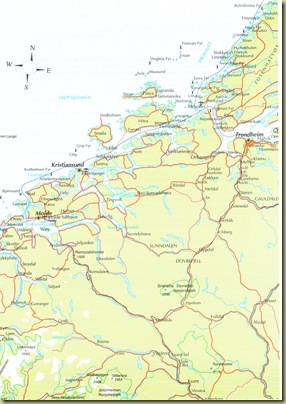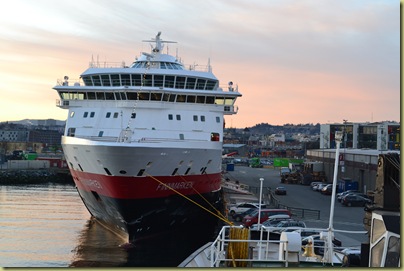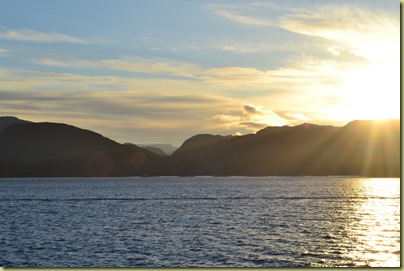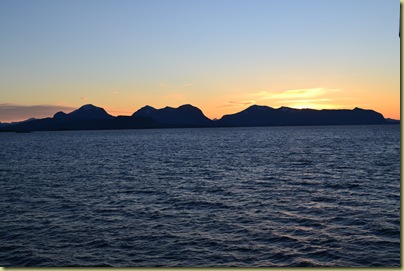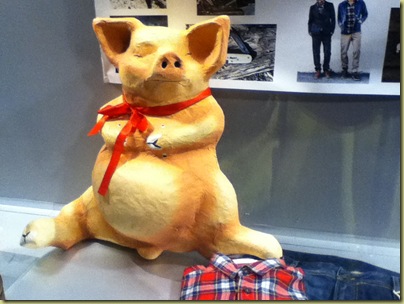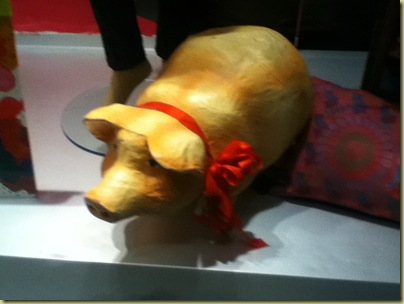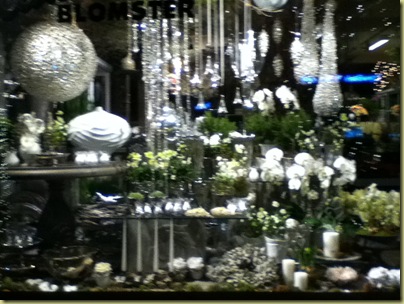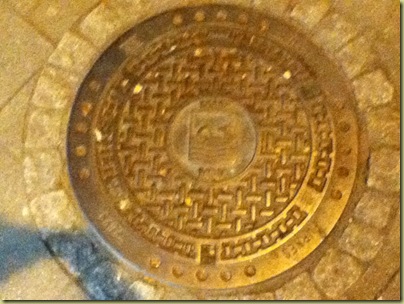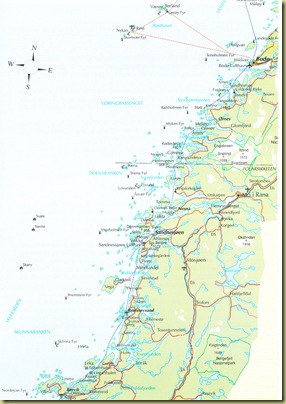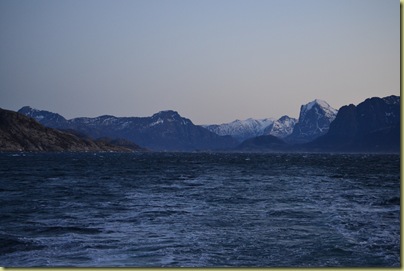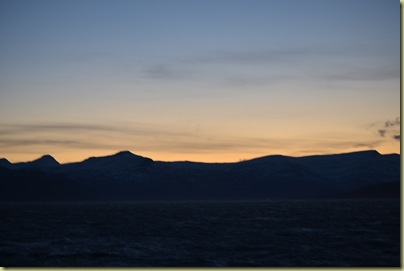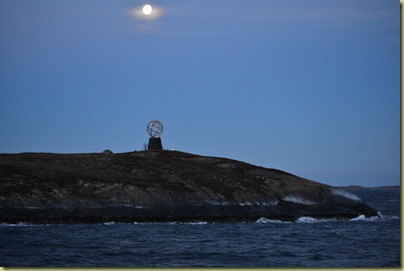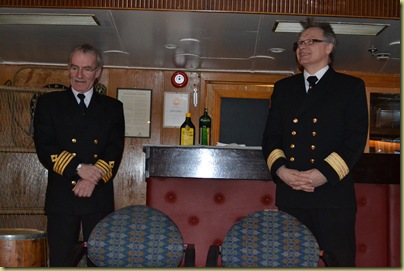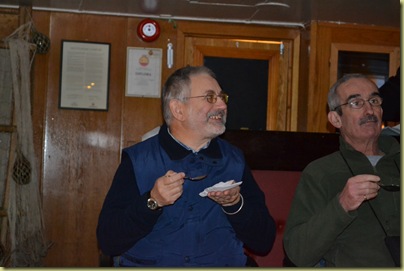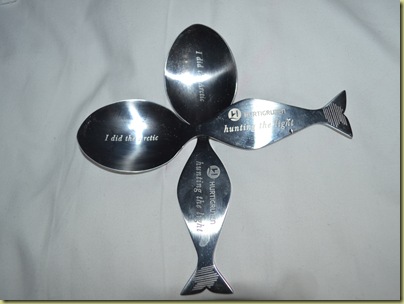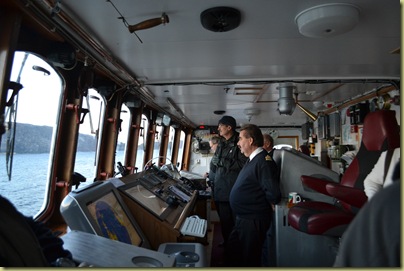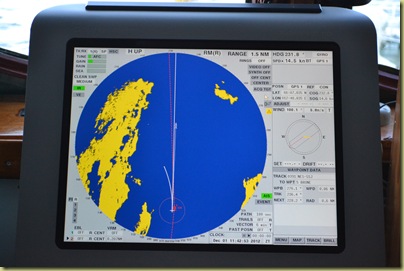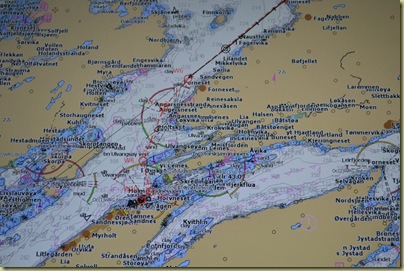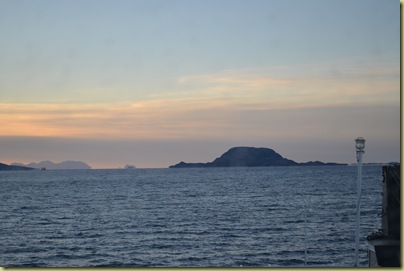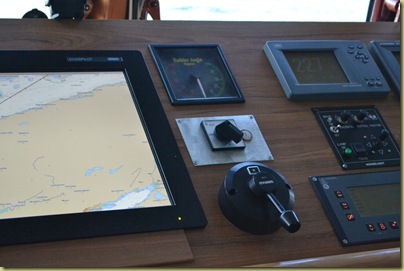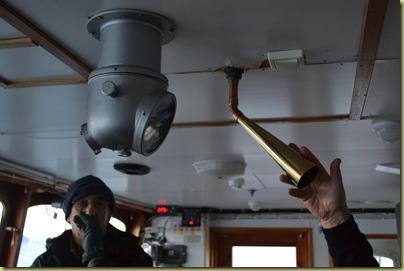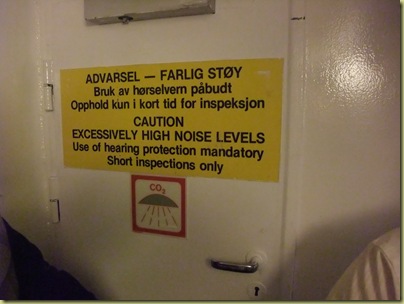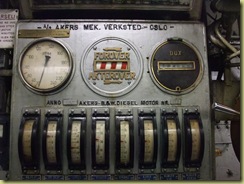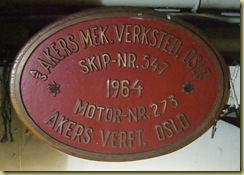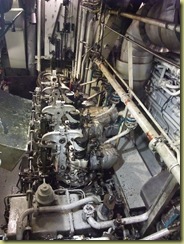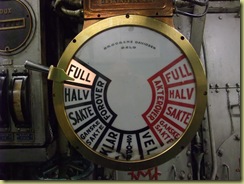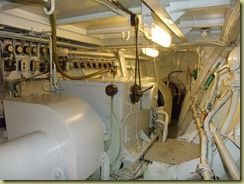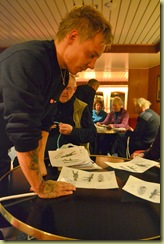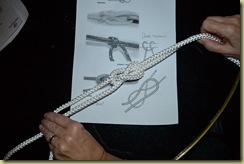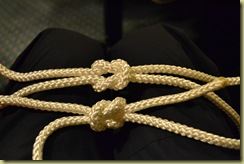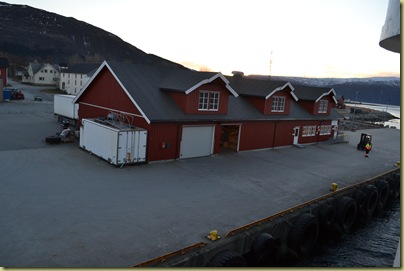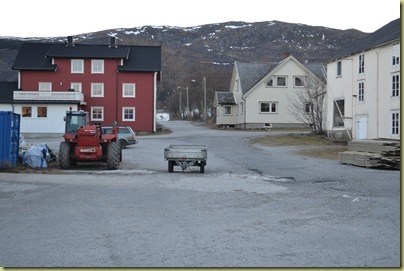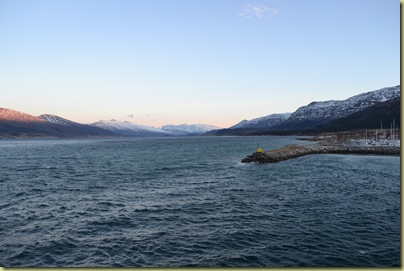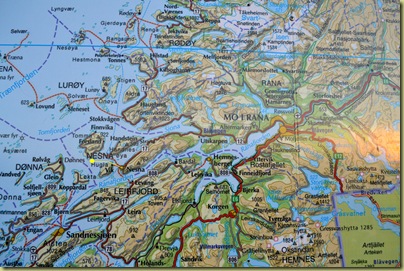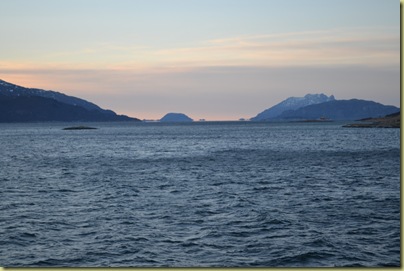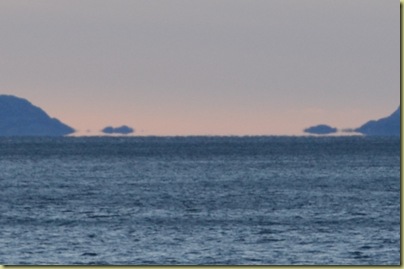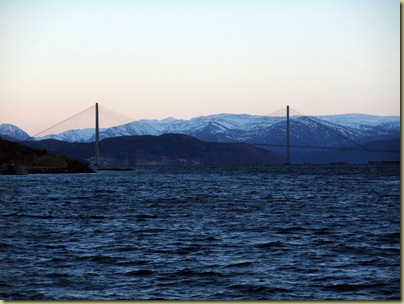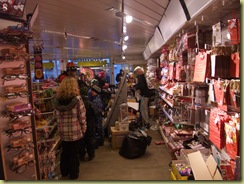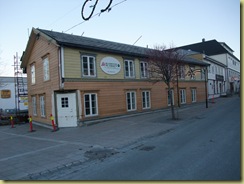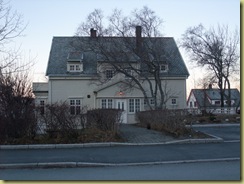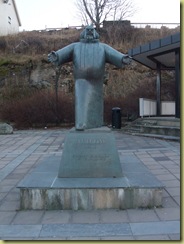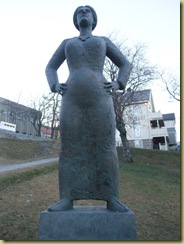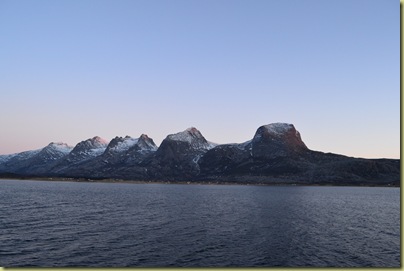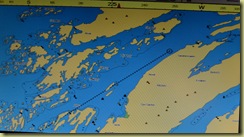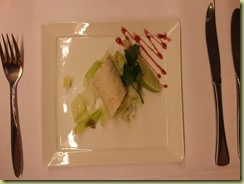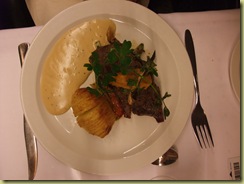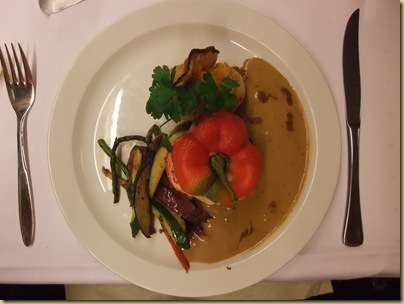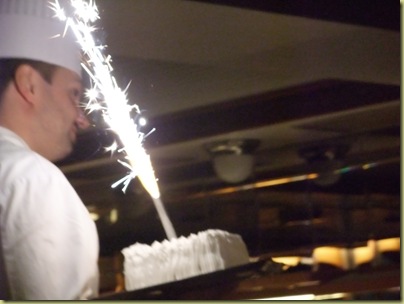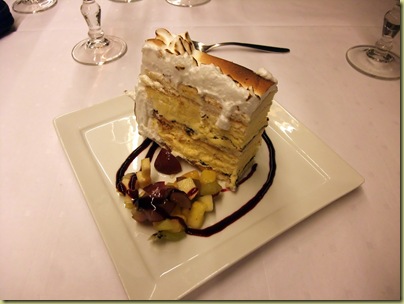The last 4½ hours of the trip are spent on the panorama lounge at the front of the ship because our cabin has to be vacated by 10 am to enable it to be prepared for the next trip and new passengers.
We steam south on a very calm sea with a clear sunny sky and reports of temperatures of –7c in Bergen (it was 8c when we arrived 12 days ago).
Although the scenery is nothing spectacular, the occasional something pops up to delight us such as this island which
is not very large but has on it a few houses
arranged around a light house. All of the islands have a slight covering of snow although it feels too cold outside to snow.
Then we pass through a very narrow channel called
Shomakeren Channel which is named after a shoemaker who lived nearby and made a good living from repairing the shoes of sailors on passing ships.
It is marked by a couple of lights,
one on either side of the channel.

It looks narrow to us and would feel even narrower on larger ships in the fleet and apparently is so narrow that the largest ships often choose to avoid it, particularly at night.
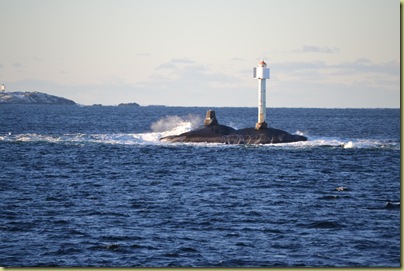
One thing we noticed when sailing up the coast was that almost every rock was marked by a lighthouse or small light such as those in the photographs above.
As we approach Bergen, we are greeted by a snowy landscape
and shortly we see an empty Hurtigruten quay awaiting our on-time arrival.
The MS-Lofoten’s Fog Horn
I have been attempting to record the Lofoten’s fog horn for a number of days without success.
It does not sound it if we are in the “official fleet hours of darkness” (not when it is actually dark because that can be most of the day).
It sometimes sounds it when we pass another ship of the fleet but the convention is that the north bound ship determines if it is to be lights flashing or fog horns sounding and all of the ships in the past few days have flashed lights.
It also sounds it when we approach a port and about five minutes before we leave it but again, only in the official hours of day light.
A combination of all of the above rules means that I have not managed to record it during the past week!
However – my failed attempts have (apart from creating some mirth amongst my fellow passengers) come to the attention of our Guide and the ship’s Captain and it has been agreed that I will be given prior warning of when it sounds as we approach our final destination. They have also agreed to sound the noisier of the two fog horns and so, 10 minutes out of the port I get to hear the horn
and if you click on the play arrow above, you will hear all 22 seconds of it yourself!
And so, we arrive and disembark for the last time,
and we get a last view of the MS Lofoten which will be leaving port to repeat the trip (in about 8 hours time) as it has done more than 1500 times over the past 48 years and will continue so to do until around 2018 when it might be taken out of service.

Our bags have arrived back in the terminal before we do,
the ever efficient Norwegian transport system ensures that the coach to the airport is waiting outside of the terminal
and about 5 minutes after getting off the Lofoten, we are moving with speed along snowy roads towards the airport in a country
where they have even cleared the pavements of snow. Snow does not seem to cause any problems here.
Our flight home is nearly empty (16 passengers in a 169 seat plane) and arrives on time and follows the usual route with three
times round the holding pattern to the east of London because of congestion at Heathrow.
Putting to one side the breakdown of the inter-terminal railway at Heathrow Terminal 5 giving us a 30 minute delay and a long walk plus the fact that only two of the e-passport gates were working, we quickly collect our bags, eventually get to our car and drive home on nearly deserted snow free roads.
And so, 12 days and 13 hours after we closed our front door, we open it again to a warm house (thank-you Monica) and unpack before going to bed.
And on the following morning, we wake up to the news that our local airport is closed because 1 cm of snow has fallen on the runway overnight. This would never happen in Norway!!!
So what did we think of our trip?
It is difficult to summarise a 12 day trip like this but:
We travelled there and back independently because we thought the Hurtigruten quoted charge for arranging flights, a hotel and buses was ridiculously high. So high in fact, that our own costs of getting to Bergen and back (for the two of us) were less than the Hurtigruten charge for one person.
The hotel we stayed at in Bergen (The Terminus) was fine and we have no complaints or comments at all on it.
The MS Lofoten
The MS Lofoten is a lovely old ship (48 years old). The key word here is “old” – it creaks and rattles a bit, it is faded in parts, it has no stabilisers, it has “no” many things and that is why people choose it. The crew work hard at maintaining it. We found them cleaning the outside windows at 11 pm when we were in one port, and the cleaner onboard when we seemed to be polishing the brass and sweeping spotless floors continuously. Heating on the ship was a bit erratic – we were either far too hot or a little cold, again it is an old ship thing.
The Lofoten is small and that is its greatest asset because provided you make an effort to join in, then you rapidly become part of its small family. I think that in high season with some 350 people on board, it might feel a bit over crowded and certainly the forward lounges (on two levels) could not house everyone if they wanted to see things from the front.
Overall, the cabins are ok. We were lucky with our one which was excellent, those down in the bowels of the ship might feel a bit cramped and some might be noisy but I have no means of comparing these cabins to those on the larger ships – they might be exactly the same and this might not be a small ship thing.
Do you want to travel in a home or a hotel is really the question you should ask when choosing a ship.
The food
Dinner was well presented and very good and not over-facing in quantity. Lunch similarly was very good although the vegetarian hot meal option rarely looked (or tasted) inviting. The lunch salad buffet and numerous desserts were superb. Breakfast was ok but only barely so for vegetarians.
Alcoholic drinks are ridiculously expensive (a Norway not a Hurtigruten thing) but you can drink your own alcohol in your cabin (absolutely not anywhere else in the ship). Whilst you can get water with your meal, the staff are not allowed to leave a carafe of water on your table unless you have paid 19NoKr for it and there is no tap or jug of water for you to top up your glass yourself. This seems very peculiar and as a result I felt thirsty during most meals.
The company has a policy of moving tourists meal times to accommodate trips (a perfectly reasonable thing) or to accommodate groups coming onboard at a port to eat a meal (this seems to be a Norwegian custom) and the subsequent meal times were far too early. When you are going out on a Hurtigruten arrange tour, there is no facility for you to substitute a meal for a packed meal (which you could then eat when you were hungry and at a more appropriate time) and therefore you have to sneakily make something at the table and take it out with you.
Ship’s Services
All ships have an on-board Tour Leader. Ours was the multi-lingual 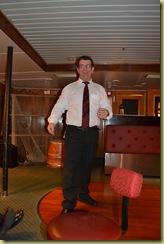 Asgeir Larsen and we thought he worked very hard to ensure that our trip went smoothly and that when there were hitches (such as not enough people to run a booked excursion) that an alternative was provided. He also had a sense of humour and on most occasions, could match ours!
Asgeir Larsen and we thought he worked very hard to ensure that our trip went smoothly and that when there were hitches (such as not enough people to run a booked excursion) that an alternative was provided. He also had a sense of humour and on most occasions, could match ours!
Every night after dinner, we collected a programme for the following day which showed port arrival and departure times, places of significance, ship passing times etc. Written by Asgeir, it was very useful. Our cabin was cleaned promptly and well every morning whilst we were at breakfast. The right time of year We chose to go in winter because we wanted to see the snow and the northern lights. We only saw snow up in the far north and we saw the northern lights on three evenings. Seeing either is a bit of a gamble and we won on this occasion. We understand why people repeat the trip in their “other season” and when time allows, we will do a summer trip. We might go on a larger boat because although it will have more passengers, it will have much more space and therefore might not feel as crowded (as we think the Lofoten might) when it is full. In summary A great 12 days which we thought was good value for money. We travelled with a great bunch of fellow travellers and thought that the service the Hurtigruten staff gave us was excellent. Next – In February 2013, polio vaccine distribution in India with my Rotary club.
